The Kingdom of Denmark is the southernmost of the Nordic countries, says Wikipedia.org.
The country consists of a large peninsula, Jutland (Jylland) and a large number of islands, most notably Zealand (Sjælland), Funen (Fyn), Vendsyssel-Thy, Lolland, Falster and Bornholm as well as hundreds of minor islands often referred to as the Danish Archipelago.
The Faroe Islands and Greenland are autonomous provinces of Denmark with home rule.
Denmark is a constitutional monarchy with a parliamentary system of government.
- It is a member of NATO and the European Union.
- Originally a seafaring nation relying on fishing, farming and trade, Denmark experienced steady industrialization in the 19th and 20th centuries and developed the Scandinavian model welfare state. I
- It has been ranked as "the happiest place in the world," based on standards of health, welfare, and education.
The Roman provinces maintained trade routes and relations with native tribes in Denmark and Roman coins have been found in Denmark. Evidence of strong Celtic cultural influence dates from this period in Denmark.
During the 8th-11th centuries, the Danes were known as Vikings, together with Norwegians and Swedish Geats. Viking explorers first discovered and settled Iceland in the 9th century, on their way toward the Faroe Islands. From there, Greenland and Vinland (Newfoundland) were also settled.
Utilizing their skills in shipbuilding they raided and conquered parts of France and the British Isles. But they also excelled in trading along the coasts and rivers of Europe, running trade routes from Greenland in the north to Constantinople in the south via Russian rivers.
The Danish Vikings were most active in the British Isles and Western Europe, and they raided, conquered and settled parts of England (their earliest settlements included Danelaw, Ireland, France, Normandy).
Monday, March 03, 2008
Subscribe to:
Post Comments (Atom)


No comments:
Post a Comment